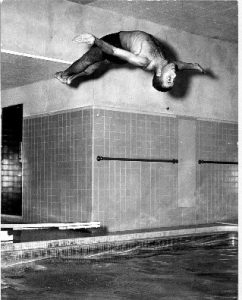For 100 years, the Druid Hill Y has occupied a significant place in Baltimore’s history as a symbol of opportunity, enabler of personal growth and advancement of the cause of equality for all. An inextricable part of the Druid Hill/Upton community through vibrant as well as more challenged times, the Druid Hill Y has been home to and instrumental in the formative years of tens of thousands of Baltimoreans from every walk of life. It has played a particularly meaningful role in the development of African Americans living in and around Druid Hill during segregation and throughout Baltimore’s history, as a focal point for physical, mental and spiritual well-being.
Notably, during the era of segregation, the Druid Hill YMCA was the only place in Baltimore where African Americans could swim in an indoor pool. As children, Thurgood Marshall, who rose to become the first African American Justice of the Supreme Court, and jazz legend Cab Calloway both lived in walking distance and learned to swim at the Druid Hill Y.
The Druid Hill Y, however, has a rich and illustrious history that began before it moved to its current home at 1609 Druid Hill Avenue. As early as 1869, African American clergymen organized by Bishop Alexander Wayman of the Bethel AME Church were meeting to discuss concerns about religion, job opportunities, education, public accommodations, and juvenile problems. A successor group, Mutual Brotherhood of Liberty of the United States, was formed by Reverend Harvey Johnson of Union Baptist Church. The keynote speaker of the inaugural meeting was none other than the social reformer and statesman, Frederick Douglass.
The principal aim of this group was to reverse the erosion of African American rights that the Supreme Court began in 1883 by declaring the 1875 Civil Rights Act unconstitutional. The group sponsored the City-Wide Young People’s Forum to provide recreational experiences for African American youth and, in 1893, the group petitioned the Central YMCA (as it was then known) to become the “Colored YMCA of Baltimore” (the description in use and commonly accepted at the time). Three years later, in 1896, the “Colored YMCA” was recognized. Original members of the Colored Y included John Murphy (editor of the Afro-American Weekly), Dr. George B. Murphy (a high school principal) and other community notables. From 1893 to 1910, the Colored Y moved to four different buildings in the Druid Hill neighborhood, accommodating a growing membership.
In 1911, a campaign for a permanent building was launched with a gift of $25,000 from the philanthropist Julius Rosenwald, a part owner of Sears and Roebuck. The gift was a matching grant contingent on the board raising an additional $75,000 in five years. Baltimoreans responded with $116,516 in donations.
The Druid Hill YMCA opened in its present location at 1609 Druid Hill Avenue in the middle of World War I, and the membership soared from 172 to 812. The Great Depression brought severe suffering and greater need for the programs offered at the Druid Hill YMCA. Paid membership and financial resources dropped at the very time that the demand for services increased. During this period, the staff hung on and even missed some paydays. Members of the board often dug deep into their own pockets to keep operations going.
Examples of the Y’s responsiveness to the community abound and extend through to this day. During World War II, the Druid Hill YMCA offered a 62 bed dormitory to African American military personnel when hotels in Baltimore were segregated.
When summer camping facilities were denied to Baltimore African Americans, the Y opened Camp Druid Hill on 286 acres on the banks of the Patuxent. The Druid Hill Y also played a key role as a convener during the Civil Rights struggle and led efforts to rebuild West Baltimore after the riots in the wake of Dr. King’s assassination.
In 2010, with the help of many volunteers and donors, the Y in Central Maryland facilitated the complete renovation of the Druid Hill Y, making it a state of the art center for health and well-being. Responding to the economic and social conditions of the surrounding community, in 2014 the Y’s Board approved a significant rate reduction for membership. The Druid Hill Y was also one of very few institutions in the area that stayed open with extended hours during the civil disturbances which occurred in the spring of 2015.
The Druid Hill Y is now home to a rich array of programs fostering youth development, healthy living and social responsibility serving the individuals, families and youth of the Druid Hill/Upton and surrounding communities now and for centuries to come.
Special thanks to Bradley Alston, a long-time Y associate, and Derek Wilson, a Druid Hill Y Board member in the 1980s, for their contributions to the research and writing of this commemorative display.
We are also deeply grateful to our generous 100th Anniversary sponsor:
![]()
















0 Comments